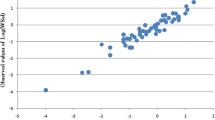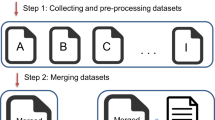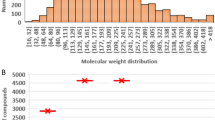Abstract
Purpose. To derive a QSPR model for estimation of aqueous solubility of organic compounds.
Methods. Solubility data for 930 diverse compounds was investigated with principal component regression analysis. This set of compounds consists of pharmaceuticals, pollutants, nutrients, herbicides, and pesticides. The diversity of this collection was analyzed using MACCS fingerprint and BCUT chemistry space.
Results. The training set of the solubility data is as diverse as the Available Chemicals Directory, and more diverse than the MDL Drug Data Report. Forty-six molecular descriptors were screened using a genetic algorithm. A QSPR model with a squared correlation coefficient (r2) of 0.92, a root mean square error of 0.53 log molar solubility (log Sw), an average absolute estimation error of 0.36 log Sw, and a cross-validated q2 of 0.91 was derived. The QSPR model was validated with a test set of 249 compounds not included in the training set. The absolute estimation error for the test set of compounds was 0.39 log Sw.
Conclusions. A highly predictive QSPR model for estimating aqueous solubility was derived and validated. This model can be used to estimate aqueous solubility for virtual screening and combinatorial library design.
Similar content being viewed by others
REFERENCES
A. K. Ghose, V. N. Viswanadhan, and J. J. Wendoloski. A knowledge-based approach in designing combinatorial or medicinal chemistry libraries for drug discovery. 1. A qualitative and quantitative characterization of known drug databases. J. Comb. Chem. 1:55–68 (1999).
C. A. Lipinski, F. Lombardo, B. W. Dominy, and P. J. Feeney. Experimental and computational approaches to estimate solubility and permeability in drug discovery and development setting. Adv. Drug Deliv. Rev. 23:3–25 (1997).
D. E. Clark. Rapid calculation of polar molecular surface area and its application to the prediction of transport phenomena. 2. Prediction of blood-brain barrier penetration. J. Pharm. Sci. 88: 815–821 (1999).
C. Hansch, J. E. Quinlan, and G. L. Lawrence. The linear free energy relationship between partition coefficients and the aqueous solubility of organic liquids. J. Org. Chem. 33:347–350 (1968).
E. J. Lien, L. L. Lien, and H. Gao. Structure-system-activity relationship analysis of drug disposition. In F. Sanz, J. Giraldo, and F. Manaut (eds.), QSAR and Molecular Modeling: Concept, Computational tools and Biologic Applications, Prous Science Publishers, Barcelona, 1995 pp. 94–100.
S. H. Yalkowsky and S. C. Valvani. Solubility and partitioning of nonelectrolytes in water. J. Pharm. Sci. 69:912–922 (1980).
Y. Ran and S. H. Yalkowsky. Prediction of drug solubility by the general solubility equation (GSE). J. Chem. Inf. Comput. Sci. 41:354–357 (2001).
N. Jain and S. H. Yalkowsky. Estimation of the aqueous solubility I: Application to organic nonelectrolytes. J. Pharm. Sci. 90: 234–252 (2001).
G. Klopman, S. Wang, and D. M. Balthasar. Estimation of aqueous solubility of organic molecules by the group contribution approach. Application to the study of biodegradation. J. Chem. Inf. Comput. Sci. 32:474–482 (1992).
J. Huuskonen. Estimation of aqueous solubility for a diverse set of organic compounds based on molecular topology. J. Chem. Inf. Comput. Sci. 40:773–777 (2000).
N. Bodor and M. J. Huang. A new method for the estimation of the aqueous solubility of organic compounds. J. Pharm. Sci. 81: 954–959 (1992).
S. H. Yalkowsky and R. M. Dannelfelser. The Arizona Database Of Aqueous Solubility, College of Pharmacy, University of Arizona, Tucson, Arizona, 1990.
M. M. Morelock, L. L. Choi, G. L. Bell, and J. Wright. Estimation and correlation of drug water solubility with pharmacological parameters required for biologic activity. J. Pharm. Sci. 83:948–952 (1994).
R. J. Prankerd and R. H. McKeown. Physico-chemical properties of barbituric acid derivatives: iv. Solubilities of 5,5-disubstituted barbituric acids in water. Int. J. Pharm. 112:1–15 (1994).
G. C. Williams and P. J. Sinko. Oral absorption of the HIV protease inhibitors: A current update. Adv. Drug Delvi. Rev. 39:211–238 (1999).
I. Fichan, C. Larroche, and J. B. Gros. Water solubility, vapor pressure, and activity coefficients of terpenes and terpenoids. J. Chem. Eng. Data 44:56–62 (1999).
B. J. Aungst. P-glycoprotein, secretory transport, and other barriers to the oral delivery of anti-HIV drugs. Adv. Drug Deliv. Rev. 39:105–116 (1999).
A. Kristl. Estimation of aqueous solubility for some guanine derivatives using partition coefficient and melting temperature. J. Pharm. Sci. 88:109–110 (1999).
P. B. Myrdal, A. M. Manka, and S. H. Yalkowsky. AQUAFAC 3: aqueous functional group activity coefficients: application to the estimation of aqueous solubility. Chemosphere 30:1619–1637 (1995).
A. Kristl and G. Vesnaver. Thermodynamic investigation of the effect of octanol-water mutual miscibility on the partitioning and solubility of some guanine derivatives. J. Chem. Soc., Faraday Trans. 91:995–998 (1995).
A. Kristl. Thermodynamic investigation of the effect of the mutual miscibility of some higher alkanols and water on the partitioning and solubility of some guanine derivatives. J. Chem. Soc., Faraday Trans. 92:1721–1224 (1996).
V. J. Stella, S. Martodihardjo, and V. M. Rao. Aqueous solubility and dissolution rate does not adequately predict in vivo performance: a probe utilizing some N-acyloxymethylphenytoin pro-drugs. J. Pharm. Sci. 88:775–779 (1999).
Chemical Computing Groups, Inc. MOE 2000.02, 1255 University Street, Montreal, Quebec, Canada, H3B 3x3.
H. Gao. Application of BCUT metrics and genetic algorithm in binary QSAR analysis. J. Chem. Inf. Comput. Sci. 41:402–407 (2001).
ACD (Available Chemicals Directory), available from MDL Information Systems Inc., 14600 Catalina St., San Leandro, California 94577.
MDL Drug Data Report 99.2; MDL Information System, Inc., 1999.
R. S. Pearlman and K. M. Smith. Novel software tools for chemical diversity. Perspect. Drug Discovery Des. 9:339–353 (1998).
H. Gao, J. A. Katzenellenbogen, R. Garg, and C. Hansch. Comparative QSAR analysis of estrogen receptor ligands. Chem. Rev. 99:723–744 (1999).
NeuralWare, Inc. Technical Publishing Group, Pittsburgh, Pennsylvania 15276.
Author information
Authors and Affiliations
Corresponding author
Rights and permissions
About this article
Cite this article
Gao, H., Shanmugasundaram, V. & Lee, P. Estimation of Aqueous Solubility of Organic Compounds with QSPR Approach. Pharm Res 19, 497–503 (2002). https://doi.org/10.1023/A:1015103914543
Issue Date:
DOI: https://doi.org/10.1023/A:1015103914543




